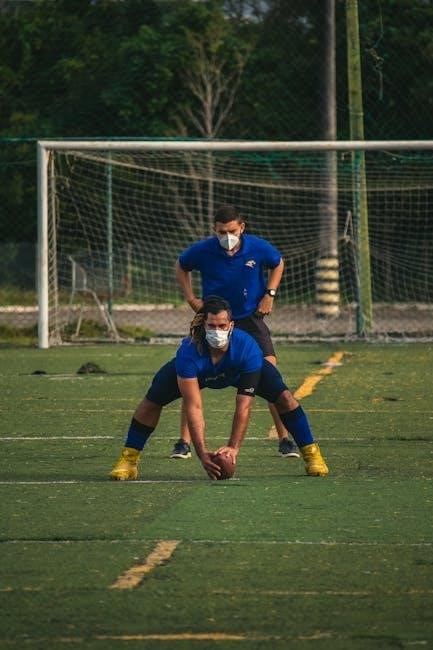The Huberman Foundational Fitness Protocol is a comprehensive, science-backed approach to achieving overall fitness, designed by neuroscientist Dr. Andrew Huberman. It focuses on strength, hypertrophy, endurance, and cardiovascular training through a structured 7-day plan.
Overview of the Protocol
The Huberman Foundational Fitness Protocol is a well-structured, 7-day workout plan designed to address all major fitness goals, including strength, hypertrophy, endurance, and cardiovascular health. It is an intermediate-level program aimed at individuals seeking a balanced approach to physical fitness. The protocol emphasizes periodization, exercise selection, and optimal workout duration to ensure progressive overload and minimize plateaus; Each day focuses on specific muscle groups or training modalities, such as legs, upper body strength, cardiovascular training, active recovery, and full-body strength. This approach ensures a holistic development of physical fitness while maintaining efficiency and sustainability; The protocol is grounded in scientific principles and is adaptable to individual needs, making it a versatile option for those looking to improve overall health and longevity. By combining strength training, cardio, and recovery, the Huberman Foundational Fitness Protocol offers a comprehensive framework for achieving long-term fitness goals.

Key Principles of the Huberman Foundational Fitness Protocol

The protocol emphasizes periodization, exercise selection, and optimal workout duration. It balances strength, hypertrophy, endurance, and cardiovascular training, ensuring progressive overload and adaptability for long-term fitness goals.
Periodization in Training

Periodization in the Huberman Foundational Fitness Protocol involves structuring workouts in specific cycles to optimize performance and prevent overtraining. Dr. Huberman emphasizes alternating between phases of higher intensity and active recovery to enhance adaptability. This approach balances strength, hypertrophy, endurance, and cardiovascular training, ensuring progressive overload. By organizing exercises into focused blocks, the protocol avoids plateaus and supports long-term fitness goals. It integrates rest days and low-intensity activities to promote recovery, making it sustainable for consistent progress. This method is central to achieving the protocol’s objective of improving overall physical fitness effectively.
Exercise Selection and Optimization

Exercise selection in the Huberman Foundational Fitness Protocol prioritizes compound movements that target multiple muscle groups simultaneously, such as squats, deadlifts, and bench presses. These exercises are chosen for their efficiency in building strength and muscle mass while minimizing training time. Accessory exercises are also incorporated to address smaller muscle groups, ensuring overall muscle balance and injury prevention. The protocol emphasizes optimal exercise sequencing to maximize metabolic stress and muscle activation, with a focus on progressive overload to drive continued progress. By combining compound and isolation exercises, the routine ensures comprehensive development across all major muscle groups. This strategic approach to exercise selection and optimization allows individuals to achieve their fitness goals effectively while maintaining training efficiency and sustainability.
Workout Duration and Efficiency
The Huberman Foundational Fitness Protocol places a strong emphasis on workout duration and efficiency, ensuring that training sessions are both effective and time-conscious. The program is designed to maximize results without excessive time commitments, making it accessible for individuals with busy schedules. Each workout is structured to target specific fitness goals within a manageable timeframe, typically ranging from 45 to 75 minutes per session. For example, Day 3 focuses on a 35-minute cardiovascular run or alternative, emphasizing consistency and sustainability. The protocol avoids unnecessary exercise volume, prioritizing quality over quantity to prevent overtraining and burnout. By optimizing workout duration, the program ensures that individuals can maintain adherence while achieving significant improvements in strength, hypertrophy, and endurance. This balanced approach to time management is a cornerstone of the protocol’s success, allowing for long-term progress without sacrificing efficiency or recovery.
Structure of the Huberman Foundational Fitness Protocol
The Huberman Foundational Fitness Protocol is a 7-day structured plan designed to optimize physical fitness. It includes targeted workouts for legs, upper body strength, cardiovascular training, active recovery, full-body strength, endurance, and rest.
Day 1: Legs ⸺ Quadriceps, Hamstrings, Calves, Tibialis
Day 1 of the Huberman Foundational Fitness Protocol focuses on lower body strength and hypertrophy, targeting the quadriceps, hamstrings, calves, and tibialis. This session is designed to build foundational leg strength, essential for overall athleticism and longevity. The workout typically includes compound movements such as squats, deadlifts, and lunges, which effectively engage multiple muscle groups simultaneously. Accessory exercises like leg press, leg curls, and calf raises are also incorporated to ensure comprehensive development. Dr. Huberman emphasizes proper form and progressive overload to maximize muscle growth and strength gains. By dedicating an entire day to leg training, the protocol ensures balanced development and avoids neglecting this critical area, which is often overlooked in many fitness routines. The structured approach ensures that each muscle group is adequately stimulated, promoting symmetry and functional strength.

Day 2: Upper Body ⸺ Strength Training
Day 2 of the Huberman Foundational Fitness Protocol focuses on upper body strength training, targeting the chest, shoulders, and triceps. This session is designed to enhance muscular strength and hypertrophy through a combination of compound and accessory exercises. Compound movements such as bench presses, overhead presses, and pull-ups are prioritized to engage multiple muscle groups simultaneously. Accessory exercises like dumbbell presses, lateral raises, and tricep dips further isolate and develop specific muscles. Dr. Huberman recommends using a 3-5 repetition range for compound lifts to maximize strength gains, while higher repetitions (8-12) are suggested for accessory exercises to promote hypertrophy. Proper form and progressive overload are emphasized to ensure continuous improvement and injury prevention. This structured approach ensures balanced upper body development, improving both aesthetic and functional strength. By dedicating a full day to upper body training, the protocol addresses common imbalances and enhances overall upper body performance.
Day 3: Cardiovascular Training ⸺ 35-Minute Run or Alternative

Day 3 of the Huberman Foundational Fitness Protocol is dedicated to cardiovascular training, emphasizing a 35-minute run or alternative cardio activity. This session aims to improve cardiovascular health, increase stamina, and enhance endurance. Dr. Huberman recommends activities like cycling, swimming, or rowing for those who prefer alternatives to running. The workout is designed to maintain a moderate intensity, ensuring sustained heart rate elevation to maximize cardiovascular benefits. Consistency is key, as regular cardio training improves heart health, boosts longevity, and enhances mental clarity. For optimal results, Huberman suggests incorporating interval training within the 35-minute session, such as alternating between high-intensity bursts and steady-state cardio. Proper hydration and a brief warm-up are advised to prepare the body for exertion. This day complements the strength-focused sessions, ensuring a well-rounded approach to fitness and overall health.

Day 4: Active Recovery and Mobility

Day 4 of the Huberman Foundational Fitness Protocol focuses on active recovery and mobility, essential for promoting muscle repair, improving flexibility, and maintaining joint health. This day involves low-intensity activities such as yoga, light swimming, or walking to enhance blood flow without overexertion. Dr. Huberman emphasizes the importance of mobility exercises to prevent stiffness and improve range of motion, particularly after strength and cardio days. Techniques like foam rolling, stretching, and dynamic movements are recommended to target major muscle groups and joints. Active recovery is not a rest day but rather an opportunity to support the body’s healing process while maintaining movement. This approach ensures long-term physical sustainability and reduces the risk of injury. Huberman suggests dedicating 20-30 minutes to these activities, ensuring a balanced and sustainable fitness routine.
Day 5: Full-Body Strength Training
Day 5 of the Huberman Foundational Fitness Protocol is dedicated to full-body strength training, designed to enhance overall muscular strength and coordination. This day focuses on compound movements such as squats, deadlifts, bench presses, and pull-ups, which work multiple muscle groups simultaneously. The goal is to improve neuromuscular efficiency and build functional strength. Dr. Huberman recommends using a repetition range of 3-5 sets of 5-8 reps for each exercise, emphasizing progressive overload to continuously challenge the muscles. Accessories like core work and isolation exercises may also be included to target specific areas. This full-body approach ensures balanced development and avoids muscle imbalances. By integrating strength training with proper form and intensity, this day reinforces the foundational aspects of the protocol, preparing the body for the upcoming endurance and hypertrophy training on Day 6.
Day 6: Endurance and Hypertrophy Training
Day 6 of the Huberman Foundational Fitness Protocol is centered around endurance and hypertrophy training, aiming to improve muscular stamina and promote muscle growth. This day typically involves higher-repetition exercises, such as 3-4 sets of 10-15 reps, targeting the same muscle groups as previous days but with a focus on volume and sustained effort. Cardiovascular endurance is also integrated, often through activities like rowing, cycling, or swimming, performed at a moderate intensity for 20-30 minutes. Dr. Huberman emphasizes the importance of progressive overload, whether through increased weight, reps, or reduced rest time, to stimulate hypertrophy. This day complements the strength-focused sessions by enhancing muscle endurance and size, ensuring a well-rounded fitness profile. The combination of endurance and hypertrophy training on Day 6 prepares the body for the final rest day, allowing for recovery and adaptation before restarting the cycle.
Day 7: Rest or Optional Low-Intensity Activity

Day 7 of the Huberman Foundational Fitness Protocol is designed for rest or optional low-intensity activity, emphasizing recovery and adaptation. This day allows the body to repair and rebuild muscle tissue, replenish energy stores, and enhance overall physiological adaptation. Complete rest is recommended for most individuals, particularly after an intense week of training. However, those who prefer light activity can engage in low-intensity exercises such as yoga, stretching, or a leisurely walk. These activities should be performed at a relaxed pace to avoid stress on the body. Dr. Huberman underscores the importance of rest for long-term progress, as it prevents overtraining and supports mental and physical rejuvenation. This day is crucial for maintaining consistency and ensuring readiness for the upcoming training cycle. By prioritizing recovery, individuals can optimize their fitness gains and overall well-being.